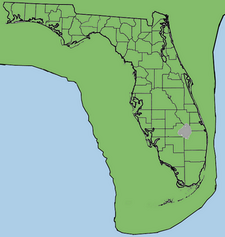| Pristine mustached bat Temporal range: Late Quaternary PreꞒ Ꞓ O S D C P T J K Pg N ↓ | |
|---|---|
| Conservation status | |
| Extinct | |
| Scientific classification | |
| Domain: | Eukaryota |
| Kingdom: | Animalia |
| Phylum: | Chordata |
| Class: | Mammalia |
| Order: | Chiroptera |
| Family: | Mormoopidae |
| Genus: | Pteronotus |
| Species: | †P. pristinus |
| Binomial name | |
| †Pteronotus pristinus Silva-Taboada, 1974 | |

The pristine mustached bat (Pteronotus (Phyllodia) pristinus) is an extinct Late Quaternary species of bat in the endemic Neotropical family Mormoopidae. It was distributed in Cuba and possibly Florida (United States).
Distribution
This bat is known only from subfossils. It was described from Late Quaternary cave deposits in Cuba (Las Villas Province, Trinidad, Cueva de los Masones) and found also in Rancholabrean cave deposits in southern Florida (Monkey Jungle Hammock).

Florida specimens (two mandibles) were only tentatively referred to Pteronotus cf. P. pristinus, because they could not be directly compared with the Cuban material (several skulls, postcranial elements), but they may represent P. pristinus.
This is the only occurrence of Pteronotus in the United States, fossil or recent. Cuba is the most likely source for West Indian bats in Florida.
Extinction

In Florida, the pristine mustached bat became locally extinct at the end of the Pleistocene, what probably resulted from the rise in sea level, the subsequent flooding of caves and loss of roosting sites.
The sea level in Florida was as much as 100 m lower in late Pleistocene, as well water tables, and cave systems in Monkey Jungle Hammock, Cutler Hammock and Rock Springs were dry. But during the latest Pleistocene the rising sea level caused flooding of these cave systems and destroyed a hot and humid microclimate of so-called hot caves. Currently two first of them are sediment-filled sinkholes few meters above sea level, third one is submerged.
In these three sites in southern peninsula, the sea level stand change presumably was also reason of extirpation of another tropical cave-dwelling bat in the Neotropical family Mormoopidae (extralimital ghost-faced bat Mormoops megalophylla) and one North American species (southeastern myotis Myotis austroriparius) as well. The fourth species - big brown bat (Eptesicus fuscus) became rare in Florida caves.
Such a pattern of extinction or extirpation is known also from many small islands in West Indies (Bahamas, Cayman Islands, Lesser Antilles).
Notes
- Mammal Species of the World, 3rd edition (MSW3) - common name probably incorrectly spelled as "Prinstine Mustached Bat" (with insterted "n" character).
References
- ^ Silva-Taboada, Gilberto (1974). "Fossil Chiroptera from cave deposits in central Cuba, with description of two new species (genera Pteronotus and Mormoops), and the first West Indian record of Mormoops megalophylla". Acta Zoologica Cracoviensia. 19 (3). Państwowe Wydawnictwo Naukowe (PWN): 33–73.
- ^ Simmons, N.B. (2005). "Pteronotus (Phyllodia) pristinus". In Wilson, D.E.; Reeder, D.M (eds.). Mammal Species of the World: A Taxonomic and Geographic Reference (3rd ed.). Johns Hopkins University Press. pp. 312–529. ISBN 978-0-8018-8221-0. OCLC 62265494.
- ^ Morgan, Gary S. & Emslie, Steven D. (2010). "Tropical and western influences in vertebrate faunas from the Pliocene and Pleistocene of Florida" (PDF). Quaternary International. 217 (1–2): 143–158. doi:10.1016/j.quaint.2009.11.030. Retrieved 11 April 2014.
- ^ Morgan, Gary S. & Emslie, Steven D. (1991). "Neotropical Chiroptera from the Pliocene and Pleistocene of Florida". Bulletin of the American Museum of Natural History. 206: 176–213.
- ^ Morgan, Gary S. (2002). "Late Rancholabrean Mammals from Southernmost Florida, and the Neotropical Influence in Florida Pleistocene Faunas". In Emry, Robert J. (ed.). Cenozoic Mammals of Land and Sea. Tributes to the Career of Clayton E. Ray (PDF). Smithsonian Contributions to Paleobiology. Vol. 93. Washington D.C.: Smithsonian Institution Press. pp. 15–38. Retrieved April 12, 2014.
- Simmons, Nancy B. & Conway, Tenley M. (February 15, 2001). "Phylogenetic relationships of mormoopid bats (Chiroptera: Mormoopidae) based on morphological data" (PDF). Bulletin of the American Museum of Natural History. 258: 1–97. doi:10.1206/0003-0090(2001)258<0001:prombc>2.0.co;2. ISSN 0003-0090. Retrieved April 15, 2014.
- National Geophysical Data Center, 1999. Global Land One-kilometer Base Elevation (GLOBE) v.1. Hastings, D. and P.K. Dunbar. National Geophysical Data Center, NOAA. doi:10.7289/V52R3PMS
- Amante, C. and B.W. Eakins, 2009. ETOPO1 1 Arc-Minute Global Relief Model: Procedures, Data Sources and Analysis. NOAA Technical Memorandum NESDIS NGDC-24. National Geophysical Data Center, NOAA. doi:10.7289/V5C8276M .
| Taxon identifiers | |
|---|---|
| Pteronotus pristinus | |